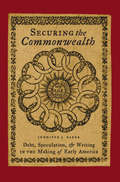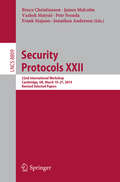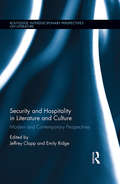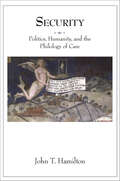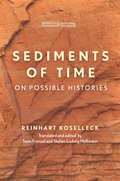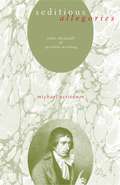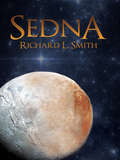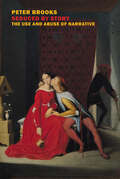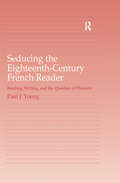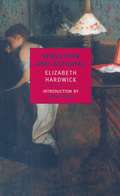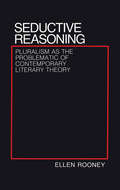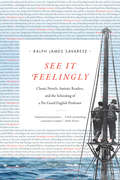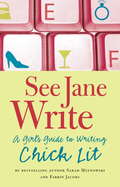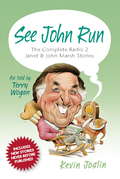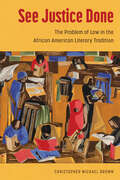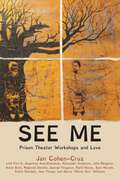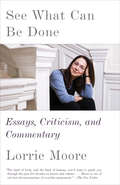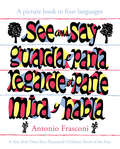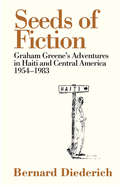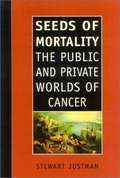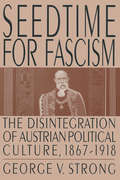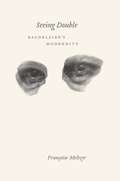- Table View
- List View
Securing the Commonwealth: Debt, Speculation, and Writing in the Making of Early America
by Jennifer J. BakerSecuring the Commonwealth examines how eighteenth-century American writers understood the highly speculative financial times in which they lived. Spanning a century of cultural and literary life, this study shows how the era's literature commonly depicted an American ethos of risk taking and borrowing as the peculiar product of New World daring and the exigencies of revolution and nation building. Some of the century's most important writers, including Cotton Mather, Benjamin Franklin, Royall Tyler, Charles Brockden Brown, and Judith Sargent Murray, believed that economic and social commonwealth—and one's commitment to that commonwealth—might be grounded in indebtedness and financial insecurity. These writers believed a cash-poor colony or nation could not only advance itself through borrowing but also gain reputability each time it successfully paid off a loan. Equally important, they believed that debt could promote communality: precarious public credit structures could exact popular commitment; intricate financial networks could bind individuals to others and to their government; and indebtedness itself could evoke sympathy for the suffering of others. Close readings of their literary works reveal how these writers imagined that public life might be shaped by economic experience, and how they understood the public life of literature itself. Insecure times strengthened their conviction that writing could be publicly serviceable, persuading readers to invest in their government, in their fellow Americans, and in the idea of America itself.
Security Protocols XXIII
by Jonathan Anderson Bruce Christianson Petr Švenda Vashek Matyáš James Malcolm Frank StajanoThis book constitutes the thoroughly refereed post-workshop proceedings of the 23rd International Workshop on Security Protocols, held in Cambridge, UK, in March/April 2015. After an introduction the volume presents 18 revised papers each followed by a revised transcript of the presentation and ensuing discussion at the event. The theme of this year's workshop is "Information Security in Fiction and in Fact".
Security and Hospitality in Literature and Culture: Modern and Contemporary Perspectives (Routledge Interdisciplinary Perspectives on Literature)
by Emily Ridge Jeffrey ClappWith contributions from an international array of scholars, this volume opens a dialogue between discourses of security and hospitality in modern and contemporary literature and culture. The chapters in the volume span domestic spaces and detention camps, the experience of migration and the phenomena of tourism, interpersonal exchanges and cross-cultural interventions. The volume explores the multifarious ways in which subjects, citizens, communities, and states negotiate the mutual, and potentially exclusive, desires to secure themselves and offer hospitality to others. From the individual’s telephone and data, to the threshold of the family home, to the borders of the nation, sites of securitization confound hospitality’s injunction to openness, gifting, and refuge. In demonstrating an interrelation between ongoing discussions of hospitality and the intensifying attention to security, the book engages with a range of literary, cultural, and geopolitical contexts, drawing on work from other disciplines, including philosophy, political science, and sociology. Further, it defines a new interdisciplinary area of inquiry that resonates with current academic interests in world literature, transnationalism, and cosmopolitanism.
Security: Politics, Humanity, and the Philology of Care (Translation/Transnation #34)
by John T. HamiltonFrom national security and social security to homeland and cyber-security, "security" has become one of the most overused words in culture and politics today. Yet it also remains one of the most undefined. What exactly are we talking about when we talk about security? In this original and timely book, John Hamilton examines the discursive versatility and semantic vagueness of security both in current and historical usage. Adopting a philological approach, he explores the fundamental ambiguity of this word, which denotes the removal of "concern" or "care" and therefore implies a condition that is either carefree or careless. Spanning texts from ancient Greek poetry to Roman Stoicism, from Augustine and Luther to Machiavelli and Hobbes, from Kant and Nietzsche to Heidegger and Carl Schmitt, Hamilton analyzes formulations of security that involve both safety and negligence, confidence and complacency, certitude and ignorance. Does security instill more fear than it assuages? Is a security purchased with freedom or human rights morally viable? How do security projects inform our expectations, desires, and anxieties? And how does the will to security relate to human finitude? Although the book makes clear that security has always been a major preoccupation of humanity, it also suggests that contemporary panics about security and the related desire to achieve perfect safety carry their own very significant risks.
Sediments of Time: On Possible Histories (Cultural Memory in the Present)
by Stefan-Ludwig Hoffmann Reinhart Koselleck Sean FranzelSediments of Time features the most important essays by renowned German historian Reinhart Koselleck not previously available in English, several of them essential to his theory of history. The volume sheds new light on Koselleck's crucial concerns, including his theory of sediments of time; his theory of historical repetition, duration, and acceleration; his encounters with philosophical hermeneutics and political and legal thought; his concern with the limits of historical meaning; and his views on historical commemoration, including that of the Second World War and the Holocaust. A critical introduction addresses some of the challenges and potentials of Koselleck's reception in the Anglophone world.
Seditious Allegories: John Thelwall and Jacobin Writing
by Michael ScrivenerThe multifaceted career of John Thelwall (1764-1834)—poet, novelist, playwright, journalist, politician, scientist—is the lens through which we are offered here a new look at the phenomenon of British Jacobinism, long distorted by the critical view of it as intellectually weak bequeathed to us by Coleridge and Wordsworth, once Jacobins themselves. This book, the first on Thelwall in almost one hundred years, combines literary analysis and historical description to show how this innovative political activist remained true to his radicalism while adapting his methods in the face of the anti-Jacobin reaction that Paine's The Rights of Man helped set off.The three parts of the book set Thelwall's achievements and challenges in the political and literary context of his times. Part One, "Jacobin(s) Writing," focuses on the most essential aspects, ideologically and formally, of the insurgent writing of the 1790s to which Thelwall contributed. Part Two, "The Voice of the People," treats both Thelwall's radical oratory and journalism, as well as his writings and activities as a natural scientist and rhetorician, a professor and technician of "elocution." Part Three, "Jacobin Allegory," expounds on Thelwall's characteristic strategy of indirect expression through synecdoche and allegory, which he used in his later career after repression forced him out of politics.Through Thelwall's life Michael Scrivener succeeds in revealing how British Jacobinism reshaped the public sphere, initiating numerous literary experiments with oratory, pamphlets, periodicals, popularizations, and songs in the spaces opened up by political associations, lectures, meetings, and trials. Jacobinism thus altered the very institutions of reading and writing by expanding literacy, restructuring the popular arena for reading, and generating a body of diverse texts that were "seditious allegories."
Sedna
by Richard L. SmithThe year is 2117. The United World Science Foundation has sanctioned a team of geologists to explore the remote minor planet known as Sedna. About one-half the diameter of Pluto, Sedna orbits twice as faraway from Earth as Pluto is, and at this distance, it receives only weak sunlight and is dark, cold, and forbidding. Discovered in the first decade of the twenty first century, the first astronauts landed on its surface in 2087. This geological team will be the first scientists to explore the surface of this remote icy world. Astronomers have been unable to explain the unusual mass, density, and gravitational attraction measured for such a small dwarf planet. The two hemispheres are dramatically different, one side similar to our moon while the other side is more like the surface of Mars. In 2104, Sedna became the home of the Sedna International Observatory. After years of construction, in 2014 its 30-meter telescope saw first light and immediately began making important discoveries. The seven-year geological mission to Sedna on starship Tesla includes a year to explore and chart the dwarf planet to answer those puzzling geological mysteries. The novel follows these scientists as they journey through our solar system, explore Sedna, and discover “something wonderful” on its surface. Technical problems on their three-year journey home forces unscheduled landings on Triton and Mars yet provides unforgettable opportunities to visit these unique worlds. An unanticipated revelation awaits them upon their return home.
Seduced by Story: The Use and Abuse of Narrative
by Peter BrooksIn this spiritual sequel to his influential Reading for the Plot, Peter Brooks examines the dangerously alluring power of storytelling.&“There&’s nothing in the world more powerful than a good story. Nothing can stop it. Nothing can defeat it.&” So begins the scholar and literary critic Peter Brooks&’s reckoning with today&’s flourishing cult of story. Forty years after publishing his seminal work Reading for the Plot, his important contribution to what came to be known as the &“narrative turn&” in contemporary criticism and philosophy, Brooks returns to question the unquestioning fashion in which story is now embraced as an excuse or explanation and the fact that every brand or politician comes equipped with one. In a discussion that ranges from The Girl on the Train to legal argument, Brooks reminds us that among the powers of narrative is the power to deceive.
Seducing the Eighteenth-Century French Reader: Reading, Writing, and the Question of Pleasure
by Paul J. YoungAs he demonstrates that narratives of seduction function as a master plot for French literature in the eighteenth century, Paul Young argues that the prevalence of this trope was a reaction to a dominant cultural discourse that coded the novel and the new practice of solitary reading as dangerous, seductive practices. Situating his study in the context of paintings, educational manuals, and criticism that caution against the act of reading, Young considers both canonical and lesser-known works by authors that include Rousseau, Sade, Bastide, Laclos, Crébillon fils, and the writers of two widely read libertine novels. How these authors responded to a cultural climate that viewed literature, and especially the novel, as seductive, sheds light on the perils and pleasures of authorship, the ways in which texts interact with the larger cultural discourse, and what eighteenth-century texts tell us about the dangers of reading or writing. Ultimately, Young argues, the seduction not in the text, but by the text raises questions about the nature of pleasure in eighteenth-century French literature and culture.
Seduction and Betrayal: Women and Literature
by Joan Didion Elizabeth HardwickThe novelist and essayist Elizabeth Hardwick is one of contemporary America's most brilliant writers, and Seduction and Betrayal, in which she considers the careers of women writers as well as the larger question of the presence of women in literature, is her most passionate and concentrated work of criticism. A gallery of unforgettable portraits--of Virginia Woolf and Zelda Fitzgerald, Dorothy Wordsworth and Jane Carlyle--as well as a provocative reading of such works as Wuthering Heights, Hedda Gabler, and the poems of Sylvia Plath, Seduction and Betrayal is a virtuoso performance, a major writer's reckoning with the relations between men and women, women and writing, writing and life.
Seductive Reasoning: Pluralism as the Problematic of Contemporary Literary Theory
by Ellen RooneySeductive Reasoning takes a provocative look at contemporary Anglo-American literary theory, calling into question the critical consensus on pluralism's nature and its status in literary studies. Drawing on the insights of Marxist and feminist critical theory and on the works of Althusser, Derrida, and Foucault, Rooney reads the pluralist’s invitation to join in a "dialogue" as a seductive gesture. Critics who respond find that they must seek to persuade all of their potential readers. Rooney examines pluralism as a form of logic in the work of E. D. Hirsch, as a form of ethics for Wayne Booth, as a rhetoric of persuasion in the books of Stanley Fish. For Paul de Man, Rooney argues, pluralism was a rhetoric of tropes just as it was, for Fredric Jameson, a form of politics.
See It Feelingly: Classic Novels, Autistic Readers, and the Schooling of a No-Good English Professor (Thought in the Act)
by Ralph James Savarese“We each have Skype accounts and use them to discuss [Moby-Dick] face to face. Once a week, we spread the worded whale out in front of us; we dissect its head, eyes, and bones, careful not to hurt or kill it. The Professor and I are not whale hunters. We are not letting the whale die. We are shaping it, letting it swim through the Web with a new and polished look.”—Tito Mukhopadhyay Since the 1940s researchers have been repeating claims about autistic people's limited ability to understand language, to partake in imaginative play, and to generate the complex theory of mind necessary to appreciate literature. In See It Feelingly Ralph James Savarese, an English professor whose son is one of the first nonspeaking autistics to graduate from college, challenges this view. Discussing fictional works over a period of years with readers from across the autism spectrum, Savarese was stunned by the readers' ability to expand his understanding of texts he knew intimately. Their startling insights emerged not only from the way their different bodies and brains lined up with a story but also from their experiences of stigma and exclusion. For Mukhopadhyay Moby-Dick is an allegory of revenge against autism, the frantic quest for a cure. The white whale represents the autist's baffling, because wordless, immersion in the sensory. Computer programmer and cyberpunk author Dora Raymaker skewers the empathetic failings of the bounty hunters in Philip K. Dick's Do Androids Dream of Electric Sheep? Autistics, some studies suggest, offer instruction in embracing the nonhuman. Encountering a short story about a lonely marine biologist in Antarctica, Temple Grandin remembers her past with an uncharacteristic emotional intensity, and she reminds the reader of the myriad ways in which people can relate to fiction. Why must there be a norm? Mixing memoir with current research in autism and cognitive literary studies, Savarese celebrates how literature springs to life through the contrasting responses of unique individuals, while helping people both on and off the spectrum to engage more richly with the world.
See Jane Write
by Sarah Mlynowski Farrin JacobsWith chick lit novels popping up on every bestseller list, millions of readers are all thinking the same thing: I could write this stuff. I could write a bestseller and never go back to the office again! And here's the guide that will show you how. Bestselling novelist Sarah Mlynowski and veteran chick lit editor Farrin Jacobs cover every stage of developing and selling your soon-to-be bestselling novel, with information on * developing an idea * learning the basics of plotting * deciding on a point of view * pacing, and conflict * making your characters likable * finding an agent --and much more, including humorous tips and advice from scores of established writers (from Meg Cabot and Marian Keyes to Emily Giffin and Sophie Kinsella). If you've got stories to tell, See Jane Write will take care of the rest!
See John Run
by Kevin JoslinFor the last four years, 8 million listeners to BBC Radio 2's Wake Up To Wogan have been beguiled and bewitched by the naughty but nice adventures of John and his wife Janet. In the style of children's stories of yesteryear, John gets up to all sorts. Then he tells Janet all about his day, by which time every perfectly innocent big end, back passage and stiff one acquires a whole new meaning... After selling over a quarter of a million recordings of their adventures, they're now available in hard covers for the first time.
See Justice Done: The Problem of Law in the African American Literary Tradition (Margaret Walker Alexander Series in African American Studies)
by Christopher Michael BrownIn See Justice Done: The Problem of Law in the African American Literary Tradition, author Christopher Michael Brown argues that African American literature has profound and deliberate legal roots. Tracing this throughline from the eighteenth century to the present, Brown demonstrates that engaging with legal culture in its many forms—including its conventions, paradoxes, and contradictions—is paramount to understanding Black writing.Brown begins by examining petitions submitted by free and enslaved Blacks to colonial and early republic legislatures. A virtually unexplored archive, these petitions aimed to demonstrate the autonomy and competence of their authors. Brown also examines early slave autobiographies such as Olaudah Equiano’s Interesting Narrative and Mary Prince’s History, which were both written in the form of legal petitions. These works invoke scenes of Black competence and of Black madness, repeatedly and simultaneously.Early Black writings reflect how a Black Atlantic world, organized by slavery, refused to acknowledge Black competence. By including scenes of Black madness, these narratives critique the violence of the law and predict the failure of future legal counterparts, such as Plessy v. Ferguson, to remedy injustice. Later chapters examine the works of more contemporary writers, such as Sutton E. Griggs, George Schuyler, Toni Morrison, and Edward P. Jones, and explore varied topics from American exceptionalism to the legal trope of "colorblindness." In chronicling these interactions with jurisprudential logics, See Justice Done reveals the tensions between US law and Black experiences of both its possibilities and its perils.
See Me: Prison Theater Workshops and Love
by Jan Cohen-CruzEncounters, transformations, and reflections from in-prison and post-release theater workshopsSee Me is a collection of intimate dialogues about collective experiences in the context of prison theater workshops. Each essay is a collaboration between two or three people who connected profoundly in the temporary community that a workshop can create. Part I is an exchange grounded in the prison theater workshop between the author and one of the incarcerated participants. They alternately tell the story of what they found in the workshop, each other, the future they imagined together, and the social turmoil and utopian aspirations of the times. Part II consists of essays jointly written by eight other people impacted by close relationships spawned in diverse in-prison and re-entry theater workshops.
See What Can Be Done: Essays, Criticism, and Commentary
by Lorrie MooreA welcome surprise: more than fifty prose pieces, gathered together for the first time, by one of America's most revered and admired novelists and short-story writers, whose articles, essays and cultural commentary--appearing in The New York Review of Books, The New York Times Book Review, The New Yorker, The Atlantic, The Guardian, Harper's Magazine and elsewhere--have been parsing the political, artistic and media idiom for the last three decades.From Lorrie Moore's earliest reviews of novels by Margaret Atwood and Nora Ephron, to an essay on Ezra Edelman's 2016 O.J. Simpson documentary, and everything in between: this book features Moore on the writing of fiction (the work of V. S. Pritchett, Don DeLillo, Philip Roth, Joyce Carol Oates, Alice Munro, Stanley Elkin, Dawn Powell, Nicholson Baker et al.) . . . on the continuing unequal state of race in America . . . on the shock of the shocking GOP . . . on the dangers (and cruel truths) of celebrity marriages and love affairs . . . on the wilds of television (The Wire, Friday Night Lights, Into the Abyss, Girls, Homeland, True Detective, Making a Murderer) . . . on the (d)evolving environment . . . on terrorism, the historical imagination and the world's newest form of novelist . . . on the lesser (and larger) lives of biography and the midwifery between art and life (Anaïs Nin, Marilyn Monroe, John Cheever, Edna St. Vincent Millay, Eudora Welty, Bernard Malamud, among others) . . . and on the high art of being Helen Gurley Brown . . . and much, much more. "Fifty years from now, it may well turn out that the work of very few American writers has as much to say about what it means to be alive in our time as that of Lorrie Moore" (Harper's Magazine).
See What Can Be Done: Essays, Criticism, and Commentary
by Lorrie MooreA welcome surprise: more than fifty prose pieces, gathered together for the first time, by one of America's most revered and admired novelists and short-story writers, whose articles, essays, and cultural commentary--appearing in The New York Review of Books, The New York Times Book Review, The New Yorker, The Atlantic, The Guardian, Harper's Magazine, and elsewhere--have been parsing the political, artistic, and media idiom for the last three decades.From Lorrie Moore's earliest reviews of novels by Margaret Atwood and Nora Ephron, to an essay on Ezra Edelman's 2016 O.J. Simpson documentary, and in between: Moore on the writing of fiction (the work of V. S. Pritchett, Don DeLillo, Philip Roth, Joyce Carol Oates, Alice Munro, Stanley Elkin, Dawn Powell, Nicholson Baker, et al.) . . . on the continuing unequal state of race in America . . . on the shock of the shocking GOP . . . on the dangers (and cruel truths) of celebrity marriages and love affairs . . . on the wilds of television (The Wire, Friday Night Lights, Into the Abyss, Girls, Homeland, True Detective, Making a Murderer) . . . on the (d)evolving environment . . . on terrorism, the historical imagination, and the world's newest form of novelist . . . on the lesser (and larger) lives of biography and the midwifery between art and life (Anaïs Nin, Marilyn Monroe, John Cheever, Edna St. Vincent Millay, Eudora Welty, Bernard Malamud, among others) . . . and on the high art of being Helen Gurley Brown . . . and much, much more. "Fifty years from now, it may well turn out that the work of very few American writers has as much to say about what it means to be alive in our time as that of Lorrie Moore" (Harper's Magazine).
See and Say: A picture book in four languages
by Antonio Frasconi"In 1953, Time magazine called Antonio Frasconi America's foremost practitioner of the ancient art of the woodcut. Four decades later, Art Journal called him the best of his generation." ― The New York Times In this New York Times Best Book of the Year, internationally renowned artist Antonio Frasconi presents beautiful and brightly colored woodcuts depicting a variety of everyday items — a boat, Christmas tree, dog, train, birthday cake, and many other eye-catching objects. The word for each image is given in English (printed in black), Italian (blue), French (red), and Spanish (green), and accompanied by pronunciation guides. A page of common expressions such as "Good morning!" and "What time is it?" in each language appears at the end. For the very young, this is a delightful picture book; for older children, it offers useful illustrated language lessons. All will enjoy the whimsical images and accompanying words and phrases.
Seeds of Fiction: Graham Greene's Adventures in Haiti and Central America 1954–1983
by Pico Iyer Richard Greene Bernard DiederichA major new biography of Graham Greene with extensive new material; exclusive, never-before-seen photographs of Greene on his travels; and full family cooperationAn essential read for fans of literary biography, this book finally and fully illuminates a pivotal episode in Graham Greene's life and career in the kind of detail that will sate any fans of his work, but which also provides a fascinating glimpse into a writer's life. In 1965, Greene joined journalist Bernard Diederich in the Dominican Republic to embark on a tour of its border with Haiti, then ruled by "Papa Doc" Duvalier. They were accompanied by activist priest Jean-Claude Bajeux. Diederich had known Greene since the mid-1950s and had lived in Haiti for 14 years. He was a seasoned correspondent for the British and North American press and had reported many stories from the region, including Castro's triumph in Cuba and the death of the Dominican dictator, Trujillo. In 1963, he had been thrown out of Haiti and when Greene arrived was working from the Dominican Republic. The famous novelist was 61 and depressed, having struggled to finish A Burnt-Out Case, and was being plagued by religious doubt; Bajeux, meanwhile, had been informed that his family had been "disappeared" by Duvalier's henchmen. As this trio traveled along the border they met a number of rebels and other characters later fictionalized in Greene's most politically charged novel, The Comedians, published the following year. This book tells the story of how a series of extraordinary and often hair-raising journeys gave one of the greatest novelists of the 20th century new inspiration in his writing.
Seeds of Mortality: The Public and Private Worlds of Cancer
by Stewart JustmanUnless the patient's mind is made healthy, "whether the tumor shrinks or even goes into complete remission, genuine healing will not have occurred."
Seedtime for Fascism: Disintegration of Austrian Political Culture, 1867-1918
by George V. StrongThis study examines the political culture in Austria-Hungary in the latter half of the 19th century. It analyzes the centrifugal forces that arose from growing ethnic nationalism in the empire and that ultimately overpowered the centripetal forces which held the Austrian-Hungarian "state idea" together. The analysis is applied further to provide an historical explanation of analogous developments in post-1989 Europe.
Seeing Double: Baudelaire's Modernity
by Francoise MeltzerThe poet Charles Baudelaire (1821–1867) has been labeled the very icon of modernity, the scribe of the modern city, and an observer of an emerging capitalist culture. Seeing Double reconsiders this iconic literary figure and his fraught relationship with the nineteenth-century world by examining the way in which he viewed the increasing dominance of modern life. In doing so, it revises some of our most common assumptions about the unresolved tensions that emerged in Baudelaire’s writing during a time of political and social upheaval. Françoise Meltzer argues that Baudelaire did not simply describe the contradictions of modernity; instead, his work embodied and recorded them, leaving them unresolved and often less than comprehensible. Baudelaire’s penchant for looking simultaneously backward to an idealized past and forward to an anxious future, while suspending the tension between them, is part of what Meltzer calls his “double vision”—a way of seeing that produces encounters that are doomed to fail, poems that can’t advance, and communications that always seem to falter. In looking again at the poet and his work, Seeing Double helps to us to understand the prodigious transformations at stake in the writing of modern life.
Seeing Double: Baudelaire's Modernity
by Françoise MeltzerThe poet Charles Baudelaire (1821–1867) has been labeled the very icon of modernity, the scribe of the modern city, and an observer of an emerging capitalist culture. Seeing Double reconsiders this iconic literary figure and his fraught relationship with the nineteenth-century world by examining the way in which he viewed the increasing dominance of modern life. In doing so, it revises some of our most common assumptions about the unresolved tensions that emerged in Baudelaire’s writing during a time of political and social upheaval.Françoise Meltzer argues that Baudelaire did not simply describe the contradictions of modernity; instead, his work embodied and recorded them, leaving them unresolved and often less than comprehensible. Baudelaire’s penchant for looking simultaneously backward to an idealized past and forward to an anxious future, while suspending the tension between them, is part of what Meltzer calls his “double vision”—a way of seeing that produces encounters that are doomed to fail, poems that can’t advance, and communications that always seem to falter. In looking again at the poet and his work, Seeing Double helps to us to understand the prodigious transformations at stake in the writing of modern life.
